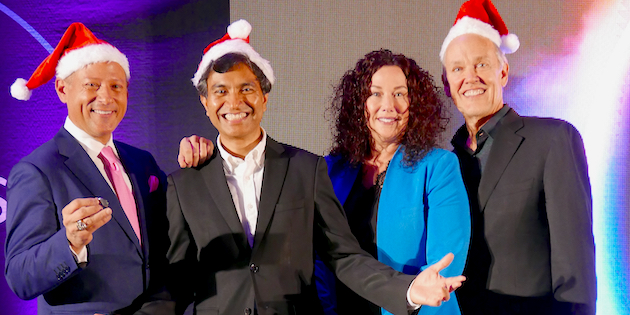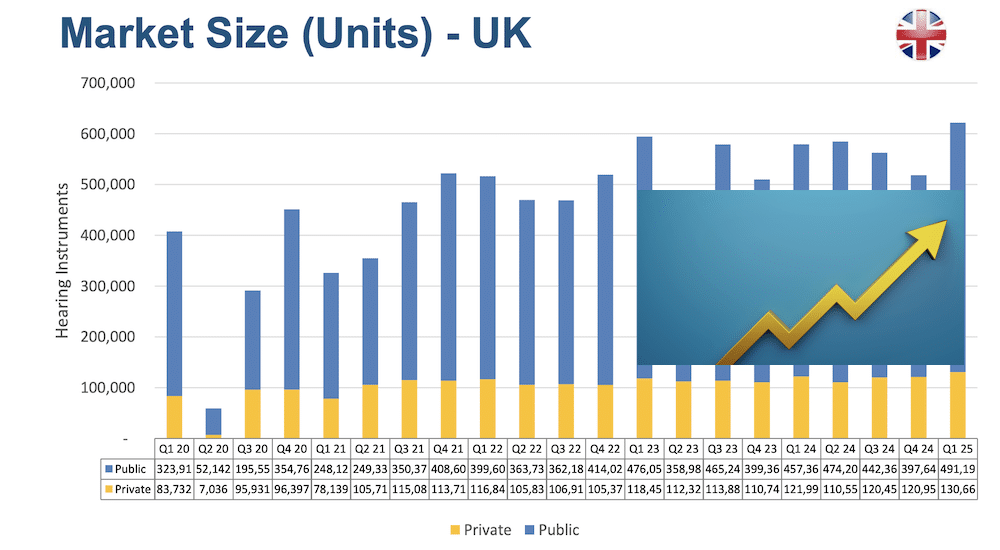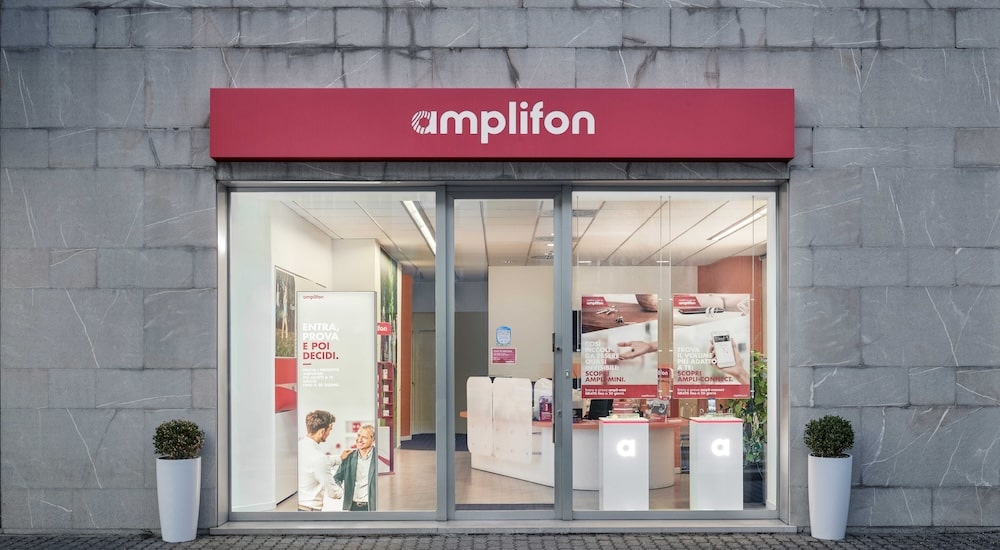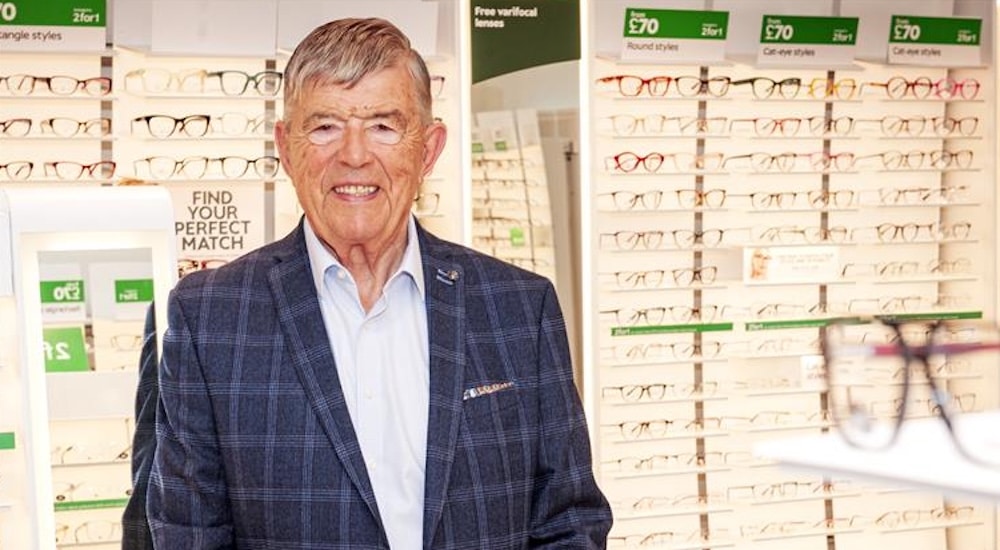FOLLOWING YONDER STARKEY
Beyond where no product has gone before, what is the mindset and ethos at America’s only global hearing aid manufacturer? Editor-in-chief Peter Wix sat down for a pre-Christmas and highly Marvel moment with Starkey at the UK launch of its new starchild, Genesis AI.

Hearing aid launches don’t come more inceptive than Starkey’s big-banging release of Genesis AI, for which – lo and behold – the faithful and curious arrived in force this autumn to find the manufacturer’s US executive Fantastic Four in Manchester, Enlgland, bringing tidings of comfort, joy, and the battery life to go with them.
“I’m a big Marvel fan,” said Starkey President and CEO Brandon Sawalich as he talked us through the origin story of a range of hearing aids that he and his fellow supes see as anything but just another release.
Genesis AI started as a vision around 2017/18, and became a journey – the secret five year Project Genesis – following a star to the point of saying “Starkey’s history is gone”, and heralding the pristine simplicity of “a new generation”.
Doesn’t it already have a nice comic book ring to it?
Reality check: of course, this here at a big round table in a Manchester hotel is part of a tech product launch to audiologist customers and prospective customers. It comes with marketing fireworks and the POW!# Whoosh!! Boom$$! of freshly inked pitch and merch. You’re not actually sitting here with the alter egos of caped crusaders, but with a businessman, Mr. Sawalich, and his team of top audiology and tech experts.
Yes, they travel as one, jetting fast – Milan, Paris, Nuremberg over three days before Manchester – and they confess to “finishing each other’s sentences”, though this is less because of any superhuman telepathy and more to do with rarely being out of contact with each other for more than two hours, weekends included. To be fair, though, like all of the good superheroes, they do a fine pre-Christmas job of talking humanistic values over mercenary goals. So, how you, reader, take lines such as “money is not the main driver” may well depend on how much you care for the comic book stuff.
Given the season of goodwill, however, finding a bit of the old Frank Capra spirit and suspending disbelief for a few paragraphs might open you to the odd insight about what hearing aids and hearing loss patients mean in the Starkey universe. Read on past the tinsel.
We can, perhaps, drop the Fantastic Four trope. It may be myopic; worse still, it means someone would have to be The Thing!
Chief Innovation Officer Dave Fabry would make, both physically and intellectually, a very plausible Dr. Reed Richards (the elastic Mr. Fantastic), but Chief Audiology Officer Sara Burdak is a hands-on audiologist and far from the Invisible Girl in our conversation. And we can’t leave the President fighting it out with his Chief Technology Officer Achin Bhowmik over who to be Ben Grimm or The Human Torch. Let’s just call them all Avengers: Brandon, and the team experts he recruited for a specific adventure, Achin, Dave, and Sara. “We had an opportunity to do something different. And I wanted to be different, be bold, be fearless, and really expanding, redefining Starkey, reinventing the hearing aid. So I went on a search outside of the industry,” explained the CEO.
If the odyssey part of that explanation reminds you of another classic of sci-fi and pop-culture, it’s because Brandon, who actually has had a five-year mission to boldly go… wanted a name to express something new, something that would grow, and that would resonate as much outside Starkey as within it. Hence: “It wasn’t, you know, just a new beginning, kind of a little bit of a Star Trek thing, and I was thinking of that to be honest.” Project Genesis had a team and a name that “gave it a personality”.
“It’s also internally for our employees. They’re proud of it. So you’ve got to think of using that and how we use it too internally, because working as a team, you’ve got over 5000 employees. You rally them. And for this, it’s also a mindset. A new generation of Starkey.”
Making complex simple…like Apple or Tesla
There is, obviously, a grail in this story, and that is the new hearing aid, Genesis AI. While you might wonder what it matters to users how many mountains were crossed to bring it to them, the story of a new dawn is one that Starkey clearly wants to communicate. As in all stories, there are messages, and in the context of an industry product, the messages can enhance brand image and brand business. And just as artificial beginnings bring humans a recharge from drawing a line and starting anew, there is a related palpable hankering in this Starkey executive team for moving ahead without complications. Making complex simple is also what they want to share with the user, evident in Brandon Sawalich’s description of the Starkey hearing aid universe as an “ecosystem that has to be intuitive”. Here, he is frank in his admiration of two companies that he sees as masters of the intuitive, Apple and Tesla.
“I have a Tesla. I’ve never read the instructions. It’s just that simple, and straightforward, the naming of things, and also you look at the marketing and it is very clear. I’m an Apple user. I’m not trying to be these companies, but what happens if Apple and Tesla had a baby, in the hearing industry: intuitive, slick design, and people just know that the quality is the best. So you know that was the vision and that you start planning, but it takes time and you’ve got to get the people.”
Finding that team and making the team work was the first great task. Sawalich has worked with or known Fabry and Burdak for twenty years, but drawing a leader of perceptual computing away from Intel – Achin Bhowmik – was the golden find, a talent the CEO describes as one who could get a top job anywhere: “But what purpose do you have developing a chip that goes into a computer? People that are coming to Starkey, they want to see their thumbprint on the final product that changes people’s lives.”
Bhowmik then had the by-no-means simple task of recruiting his own engineering team. Of his job, he now willingly enthuses: “It’s not work for us it. It is LIFE.” And of his “special” team: “Every member of my team can go work at Apple or Amazon or Google, right? But they’re with us because they want to make a make an impact on human health.”
That impact, of course, depends on the quality of the product and service, that ecosystem Sawalich likes to talk about. For the features of that product, see below. Its essence, as part of the Starkey universe, is broken down by Starkey’s leader into three supporting pillars:
“Job one, as I said, is audio, the sound experience, and then you have your health and wellness, which is our healthables. So the ears is the new wrist is what we said with Livio, and then, coming out with fall detection, but what’s next? How do we get more coactive in fall prevention? How do we help people with health and wellness, and mental health with mood detection? Are they depressed? Can we have a feature that, by the tone of their voice, tells you if somebody’s lonely, isolated? Because we know what hearing loss can do, and now all those studies are coming out [dementia].
“And then you know, finally the third pillar, the Starkey AI system is the J.A.R.V.I.S. [Just A Rather Very Intelligent System] in the ear… I’m a big Marvel fan, yes, Ironman. But how do you get that, that assistant that’s going to help you and just make it a little bit better for you that day?”
Developed in consultation with audiologists
So, apart from taking an epic product name from pop-culture sci-fi – one tracing back to cultural borrowing by Messrs. Lee and Roddenberry – to the obvious biblical reference, Starkey’s designing of its “simple and possible” hearing tech is not just carried out in an ivory tower lab in Minnesota. “Two hundred hearing healthcare professionals around the world helped design and give us feedback over those five years of our programming software,” adds Sawalich.
Sara Burdak underlines the outcomes of consulting with audiologists out there in the real world: “We have said with our technology we have designed, if it’s for the patient, it’s been designed with the patient for the patient; if it’s for the professional, it’s with the professional for the professional. And I think because of that, we know what the end results need to be and collaboratively work really well together, bringing all of our areas of expertise as a team.”
NO OTC for Starkey
One year after revealing that Starkey was “reluctantly” ready to throw an over-the-counter model – Start Hearing One – into a race in which some other major manufacturers were well past the formation lap, the firm’s leader answers Audiology News UK’s question on Starkey OTC involvement firmly in the negative. “NO,” said Sawalich. OTC, he explained, does not fit with the company’s culture.
“Our concern has always been the reputation it’s going to give, and that it will confuse, which it has,” said the Starkey President, adding that the firm’s customer office has heard from people upset with what they’ve purchased.
Clamorous from the outset against too fast a regulation of OTC by the US Food and Drug Administration (FDA), Sawalich defends having embraced the conversation. While he accepts that the Biden administration wanted the FDA to act quickly, he argues: “Let’s educate on OTC, because they treated it like a commodity, and politics aside, it’s a little insulting because we know the industry.”
Here, both Sara Burdak and Dave Fabry bolster the argument that hearing aids are not just things to sell. While Burdak points out how much customisation Starkey does in earmoulds – “more than anyone else, because it’s so important that people can wear these all day and every day” – Fabry stresses that the OTC regulation places too much emphasis on affordability of hearing aids and not enough on accessibility to fittings.
“We know from other markets around the world that while affordability is a barrier for some people, it’s just as important to have accessibility for a professional, and it [OTC] hasn’t meant that 100% of the people are going to wear hearing aids because stigma remains an issue and it’s central to what we’re doing,” Fabry explained.
And his CEO underlined the point: “When you say, ‘oh! we lowered healthcare cost’… this isn’t a pill, this isn’t something you just take. It’s a whole ecosystem that they’ve [pointing to his team] worked very hard on, and our team is very proud to get it right.”
A culture company
Again the conversation comes back to the team, but the team is keen to emphasise that they must be part of the company culture.
“We are a culture company,” says Sawalich, stressing that when he appointed Achin Bhowmik, “I had to look at is he going to be a culture fit?”
“Like I said, we finish each other’s sentences. Don’t get me wrong. I don’t want yes people. There will be times when, you know, people get frustrated. But we’ll always get back together because we know that we have a respect,” he adds before explaining that the concept of family at Starkey – a family company since 1967 when it was started by Bill Austin, who is still the owner – extends towards a culture that recruits on the basis of candidates’ credentials in caring, and rewards employees with understanding when they themselves need to be cared for.
As Dave Fabry puts it,“People are fearful of the future and fearful of disruption, and everyone’s being disrupted these days. The one thing that cannot be commoditised is caring.”
“I’ve worked for 15 years in a large clinical academic facility in the US and a number of other competitors, but Brandon and the culture within Starkey is the only place where they really identify the culture, identify the skill set, and then allow you to be – it sounds cliched – but allow you to be your authentic self, and to recognise what you can bring, and then allow you to do that,”Fabry continues.
The freedoms of NOT being a publicly traded company
Does the Starkey team appreciate any liberties that come from being a family concern, rather than a listed public outfit? “Oh yes!”
Brandon Sawalich recognises that different companies have their own directions and ways of working. The publicly traded companies, he says, “risk reward, but there are things that we could do, and we are doing that other companies won’t do because they have a different end game; they have to report to their shareholders.”
So, where exactly, does the liberty of not being public have its effect?
“Quick decisions,”says Brandon.
“It’s the agility,”says Sara.
“It’s the agility,”echoes Brandon.”I trust her. I trust Dave. If something’s wrong if they have an idea…let’s go do it! I don’t have to go ‘when’s the next board meeting?’ Or ‘do I have to fill out something?’ If we’re brainstorming in my office, and I ask ‘what do you think?’…[clicks fingers] let’s do it!”
Dave Fabry points out that this agility as a company does not just benefit Starkey.“To really emphasise, it’s patient-driven technology, not technology driven by shareholder focus. I mean the focus is really on the patient and the provider, what’s going to be best, what’s going to provide the best solutions for that, not where our share price is these days.
Difficult markets…the UK?
There should be a snag at the end of every comic book superhero tale, a last obstacle to overcome before the team’s spokesperson gets to project for another day. What about a UK plotline involving the complications of a hearing aid market divided between the NHS and the private sector?
“Every market is complicated,” says Sawalich. “If we’re focused on being private, then we pick and choose what type of channel in that market we want to focus on, and we’re not pushed by investors or wherever that we have to do this. In some markets, there’s a race to the bottom at times; we’re focused on the race to the top. And that means premium hearing technology, premium products, performance and service for people that want to hear better.”
© PW Richard Jones, Starkey’s UK MD hosted the Genesis AI launch at Manchester’s historic Kimpton Clocktower Hotel. “We are in full R&D investment mode,” said Jones.
Starkey operates today in over 100 markets, with no need for more, says Sawalich.“I think we’re kind of there, to be honest.”
And this businessman’s view of world markets, while consistent with a taste for the comic book narratives of speed, strength, power, knowledge, and the global geopolitical spread of old-fashioned American ideology and values, reflects an essential quality of the person in need: “Marketing doesn’t change. The psychology of the hearing impaired is the same in South Korea as it is in Japan as it is in Kenya, where we have an office, as it is in France and Germany. People want to hear better.”
Starkey, he bugles, has come through a team-building pandemic period which felt l“ike you’re on defence. You know you’re getting there, and for the first time right now I would say we are on offense.”
The closing line for the supes’ team leader:
“Starkey is very healthy. We define our future. Public listed companies? You look at their debt. We don’t have to worry about that because we’re focused and we make decisions based on hearing is our concern, and concern is the core of who we are.”
GENESIS AI
This is the hearing aid that marks a new generation for Starkey, says President and CEO Brandon Sawalich.
“Our number one job is sound quality,” he says, “having the best sounding hearing aid. That’s what people want, to hear better, so we have to have the best sound.”
His company’s claim for Genesis AI is based around a new Starkey Neuro Processor – “the core of everything” – with an on-board Deep Neural Network (DNN) accelerator engine that, in the words of Starkey’s Chief Technology Officer Achin Bhowmik, “borrows the architecture of the human brain” and is “a copy of the way the brain’s computing system works”. This processor improves on previous Starkey hearing aids through 6x more transistors, 10x more memory, and 4x faster processing, making 80 million adjustments every hour.
There is also a new RIC design, rechargeable up to an impressive 51 hours on a single charge, making it the longest lasting on the market.
Styles also include what Starkey is claiming as the industry’s smallest new wireless CIC.
Pro8 HydraShield makes this waterproof (to an IP68+ rating), sweatproof, and safe from dirt and dust.
There is an all-new MyStarkey App designed for fast and intuitive use, and this is where the AI tech comes to life through:
Edge Mode+, optimising sound quality in tough environments;
Fall detection, alerting family and friends to falls, four times better than previous versions and with four times fewer false positives, says Bhowmik;
Audio streaming from phones, iPhone and Android, TV, and wireless accessories;
Personal Health Monitoring, to count steps, track engagement, and achieve well-being goals;
TeleHear: Starkey Pro Fit fitting software for the professional is also new and includes this remote telehealth connection;
And of course, a Smart Assistant for patients to use their voice to make adjustments, set reminders, and so on.
More info here:
Source: First published in Audiology News UK issue 05 November-December 2023






